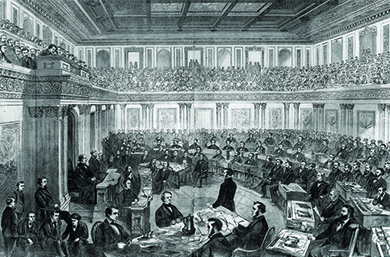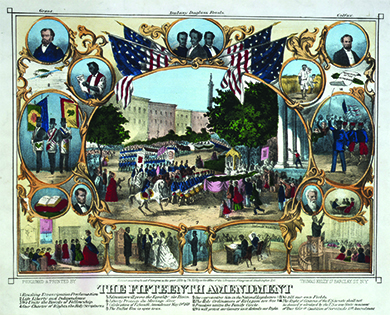| << Chapter < Page | Chapter >> Page > |

In November 1868, Ulysses S. Grant, the Union’s war hero, easily won the presidency in a landslide victory. The Democratic nominee was Horatio Seymour, but the Democrats carried the stigma of disunion. The Republicans, in their campaign, blamed the devastating Civil War and the violence of its aftermath on the rival party, a strategy that southerners called “waving the bloody shirt.”
Though Grant did not side with the Radical Republicans, his victory allowed the continuance of the Radical Reconstruction program. In the winter of 1869, Republicans introduced another constitutional amendment, the third of the Reconstruction era. When Republicans had passed the Fourteenth Amendment, which addressed citizenship rights and equal protections, they were unable to explicitly ban states from withholding the franchise based on race. With the Fifteenth Amendment, they sought to correct this major weakness by finally extending to black men the right to vote. The amendment directed that “[t]he right of citizens of the United States to vote shall not be denied or abridged by the United States or by any State on account of race, color, or previous condition of servitude.” Unfortunately, the new amendment had weaknesses of its own. As part of a compromise to ensure the passage of the amendment with the broadest possible support, drafters of the amendment specifically excluded language that addressed literacy tests and poll taxes, the most common ways blacks were traditionally disenfranchised in both the North and the South. Indeed, Radical Republican leader Charles Sumner of Massachusetts, himself an ardent supporter of legal equality without exception to race, refused to vote for the amendment precisely because it did not address these obvious loopholes.
Despite these weaknesses, the language of the amendment did provide for universal manhood suffrage—the right of all men to vote—and crucially identified black men, including those who had been slaves, as deserving the right to vote. This, the third and final of the Reconstruction amendments, was ratified in 1870 ( [link] ). With the ratification of the Fifteenth Amendment, many believed that the process of restoring the Union was safely coming to a close and that the rights of freed slaves were finally secure. African American communities expressed great hope as they celebrated what they understood to be a national confirmation of their unqualified citizenship.


Notification Switch
Would you like to follow the 'U.s. history' conversation and receive update notifications?